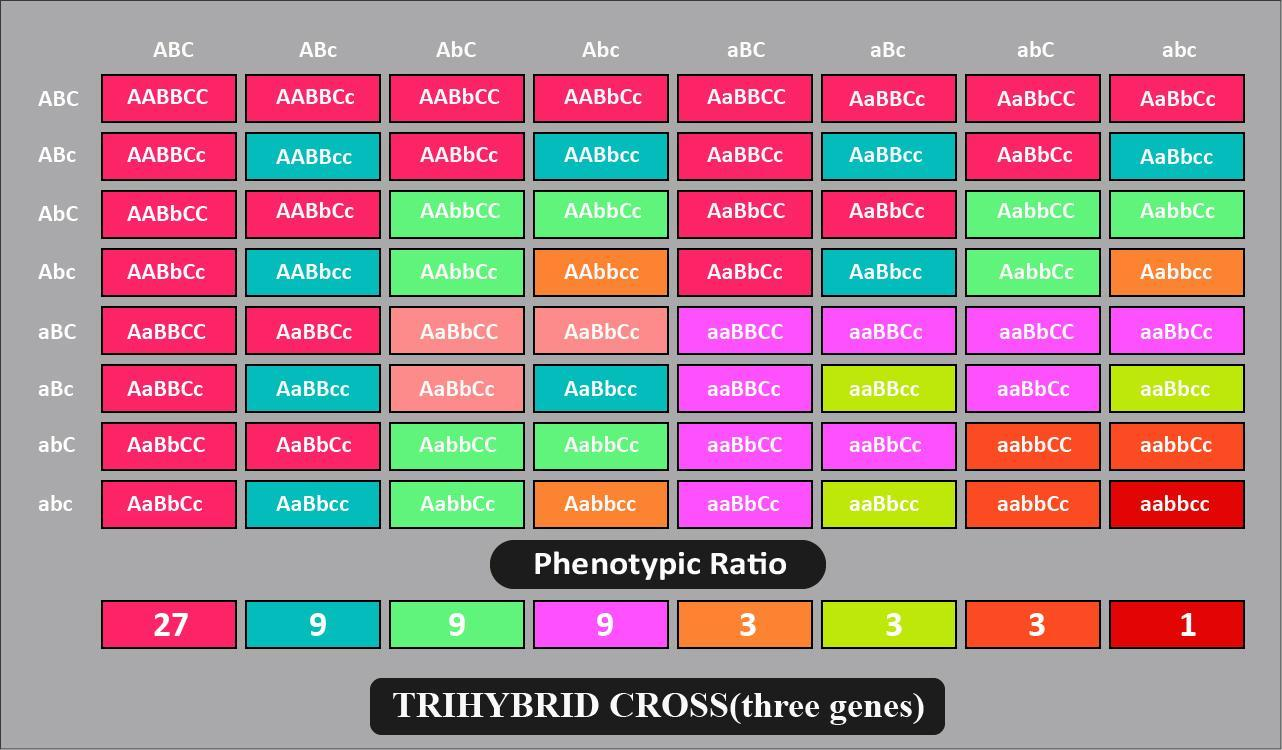
In the cross AaBBcc
 aaBbCc, what is the probability of an offspring that is aaBbcc?
aaBbCc, what is the probability of an offspring that is aaBbcc?
(a) 1/2
(b) 1/4
(c) 1/8
(d) 1/16

Answer
498k+ views
Hint: In a trihybrid cross, each gamete gets one of the alleles from each parent. Hence, we perform such crosses in punnett squares. Trihybrid cross follows all the laws given by Mendel i.e. law of segregation of gametes, law of dominance and law of independent assortment.
Complete answer:
Here, let us break down the given problem into small parts. First, we will consider a cross between Aa and aa. We will look for priority of getting a homozygous individual (since we want the final genotype to be aaBbcc.)
So, the probability of getting a homozygote (aa) is 2/4 i.e. 1/2.
Similarly, let us look into the cross between BB and Bb.
So, the probability of getting a heterozygote (Bb) is 2/4 i.e. 1/2.
Last part of the given genotype-aaBbcc is ‘cc’. Now, let us look into a cross between parental parts cc and Cc.
So, the probability of getting a homozygote (cc) is 2/4 i.e. 1/2.
In order to get all of them happening together, we will now reduce the overall chance for each genotype. So, we will multiply all three probabilities as -
So, the correct answer is ‘1/8.’
Note: Traditional method of solving this problem can be by using the punnett square. So, if we look into the punnett square of a normal trihybrid cross, we can get the probability by looking into the genotype.

Complete answer:
Here, let us break down the given problem into small parts. First, we will consider a cross between Aa and aa. We will look for priority of getting a homozygous individual (since we want the final genotype to be aaBbcc.)
| A | a | |
| a | AaHeterozygote | aaHomozygote |
| a | AaHeterozygote | aaHomozygote |
So, the probability of getting a homozygote (aa) is 2/4 i.e. 1/2.
Similarly, let us look into the cross between BB and Bb.
| B | B | |
| B | BBHomozygote | BBHomozygote |
| b | BbHeterozygote | BbHeterozygote |
So, the probability of getting a heterozygote (Bb) is 2/4 i.e. 1/2.
Last part of the given genotype-aaBbcc is ‘cc’. Now, let us look into a cross between parental parts cc and Cc.
| C | c | |
| c | CcHeterozygote | ccHomozygote |
| c | CcHeterozygote | ccHomozygote |
So, the probability of getting a homozygote (cc) is 2/4 i.e. 1/2.
In order to get all of them happening together, we will now reduce the overall chance for each genotype. So, we will multiply all three probabilities as -
So, the correct answer is ‘1/8.’
Note: Traditional method of solving this problem can be by using the punnett square. So, if we look into the punnett square of a normal trihybrid cross, we can get the probability by looking into the genotype.

Recently Updated Pages
Master Class 9 General Knowledge: Engaging Questions & Answers for Success

Master Class 9 English: Engaging Questions & Answers for Success

Master Class 9 Science: Engaging Questions & Answers for Success

Master Class 9 Social Science: Engaging Questions & Answers for Success

Master Class 9 Maths: Engaging Questions & Answers for Success

Class 9 Question and Answer - Your Ultimate Solutions Guide

Trending doubts
What are Quantum numbers Explain the quantum number class 11 chemistry CBSE

Who built the Grand Trunk Road AChandragupta Maurya class 11 social science CBSE

The reason why India adopted the policy of nonalignment class 11 social science CBSE

How much is 23 kg in pounds class 11 chemistry CBSE

The plastids which are coloured green and colourless class 11 biology CBSE

Earth rotates in which direction A East to west B West class 11 physics CBSE




